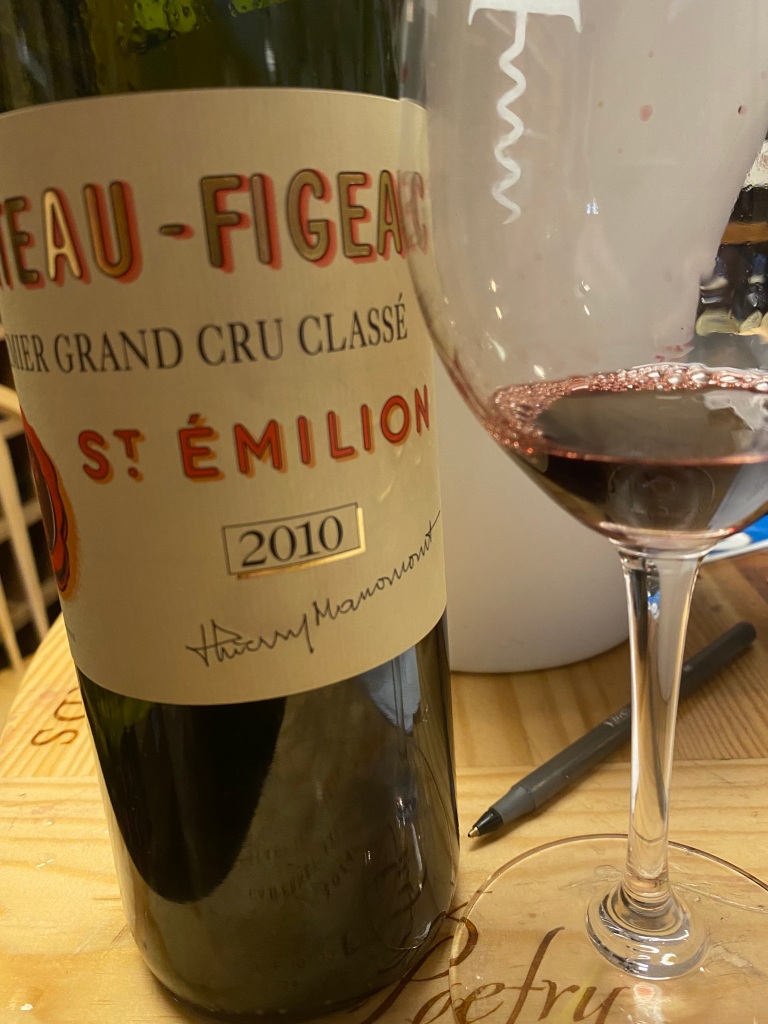The final notes on a wine tasting at my local wine shop The Fine Wine Source in Livonia, Michigan. Of the six wines up for tasting, five were from Chateau Figeac. Chateau Figeac was rated as Premier Grand Cru Classe (B) in the 1955 Saint-Emilion Classification, and this rating is not static, and in 2022, it was elevated to Premier Grand Cru Classe (A). At the shop they also had some wine from the 1998 and 2020 vintage, that were not for the tasting, but they were sold by the time I got to the shop.

The property has been an estate since Roman times, but in terms of viticulture, the estate became known following The Middle Ages. In the 18th Century the estate was much larger, but in the 19th Century sections had been sold off, including to Cheval Blanc in 1832. A couple of other properties that acquired land during dispersals, have appended “Figeac” to their titles. Most of the region favors Merlot and Cabernet Franc, but at Chateau Figeac the plots are planted thirty-five percent Cabernet Franc, thirty-five percent Cabernet Sauvignon, and thirty percent Merlot. The current estate is now forty-two-hectares and is known for have three different types of gravel soil. The fruit is hand-harvested and then inspected by video-scanning. After the fermentation process, the wine is aged in all new oak barrels for thirteen to fifteen months. We started this set with Chateau Figeac Saint-Emilion Premier Grand Cru – B 2010. During the tasting, I was talking to the representative of the wholesaler and he told me that this wine was extremely tight when it was open, but had truly mellowed, by the time I got to the tasting. The wine was a deep ruby colored wine and offered pure Bordeaux notes of red and black fruits, and ending with the classic expression of pencil shavings. On the palate the plums and raspberry were prominent, blending with very fine tannins and with a good medium count finish of fruit and terroir.

The wine is widely considered to have greatly improved since World War II, under the ownership and guidance of Thierry Manoncourt. The average age of the vines are probably around fifty years of age, and some are over the century mark, as many of the vines were personally planted by Thierry Manoncourt with some help from Madame Marie France Manoncourt. We then had Chateau Figeac Saint-Emilion Premier Grand Cru – B 2012. This dark ruby colored wine offered fresh and vibrant notes of red and black fruits, floral fragrances, and some shades of cedar, and tobacco. On the palate the tones of red fruit were most prominent, blending with the rounded tannins and finishing with a medium count of fruit and terroir.

The wines from Saint-Emilion all have the potential through quality work and techniques to become Grand Cru status, as the status since the 1955 Saint-Emilion Wine Classification is an evolving process. The concept being that the wineries will continually improve the quality of their wine. The regulations are tighter and have more restrictions in the Grand Cru classification compared to the basic appellation rules. The Grand Cru Classe designation has been conferred in 1955, updated in 2006, 2012 and 2022. Three of the four regulations concern the nuts and bolts of viticulture, and the fourth requires an extra fourteen months of storage before being released. As a side note, I have heard that some of the great houses withdrew from the listing, over requirements of visitations, parking lots and marketing requirements; some did not want to become commercial. The last wine of the tasting was Chateau Figeac Saint-Emilion Premier Grand Cru – B 2016. This wine is a blend of thirty-eight percent Cabernet Sauvignon, twenty-six percent Merlot, and twenty-six percent Cabernet Franc. A deep ruby/purple wine that offers notes of ripe black cherries, cassis, licorice, cloves, cocoa, and cedar. On the palate the tones are so elegant, and complex that it is breath-taking. It starts with the ripe fruit, but it is blended with “cashmere-like” tannins and multi-layers of pure joy, which my vocabulary cannot do it justice and it ends with a long count finish of like chocolate covered cherries. A true seductress, the 2016 vintage has been superlative for Bordeaux and of the four wines, this was tops, followed by the 1989 (which I thought was very chewy), the 2010 which was very mellow and then the 2012 (and there was absolutely nothing wrong with that wine); and that is what can drive me crazy on a vertical tasting, but oh that 2016. I might add that the 2016 received 98 points by Parker, 99 points by Suckling, and 100 points by Decanter.
